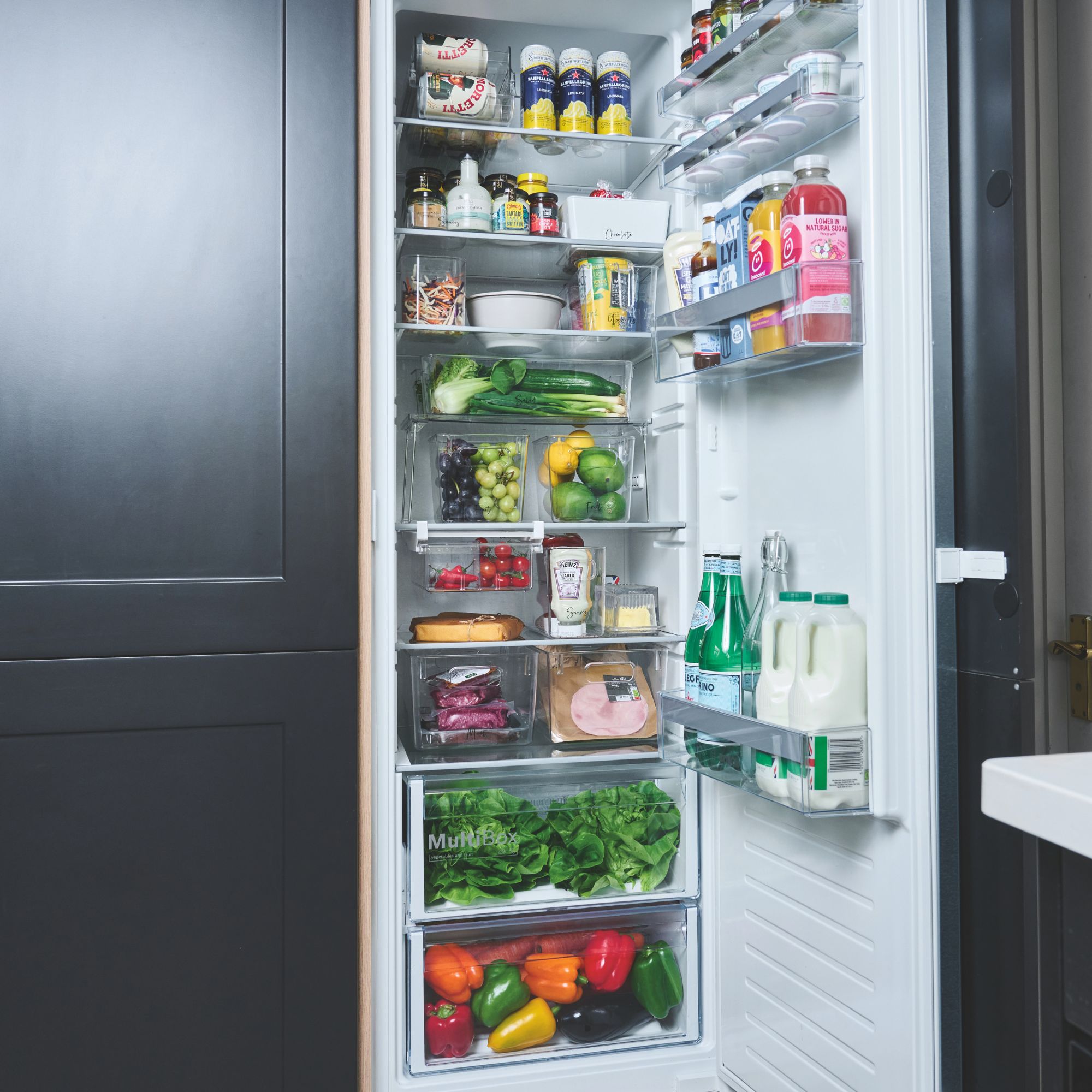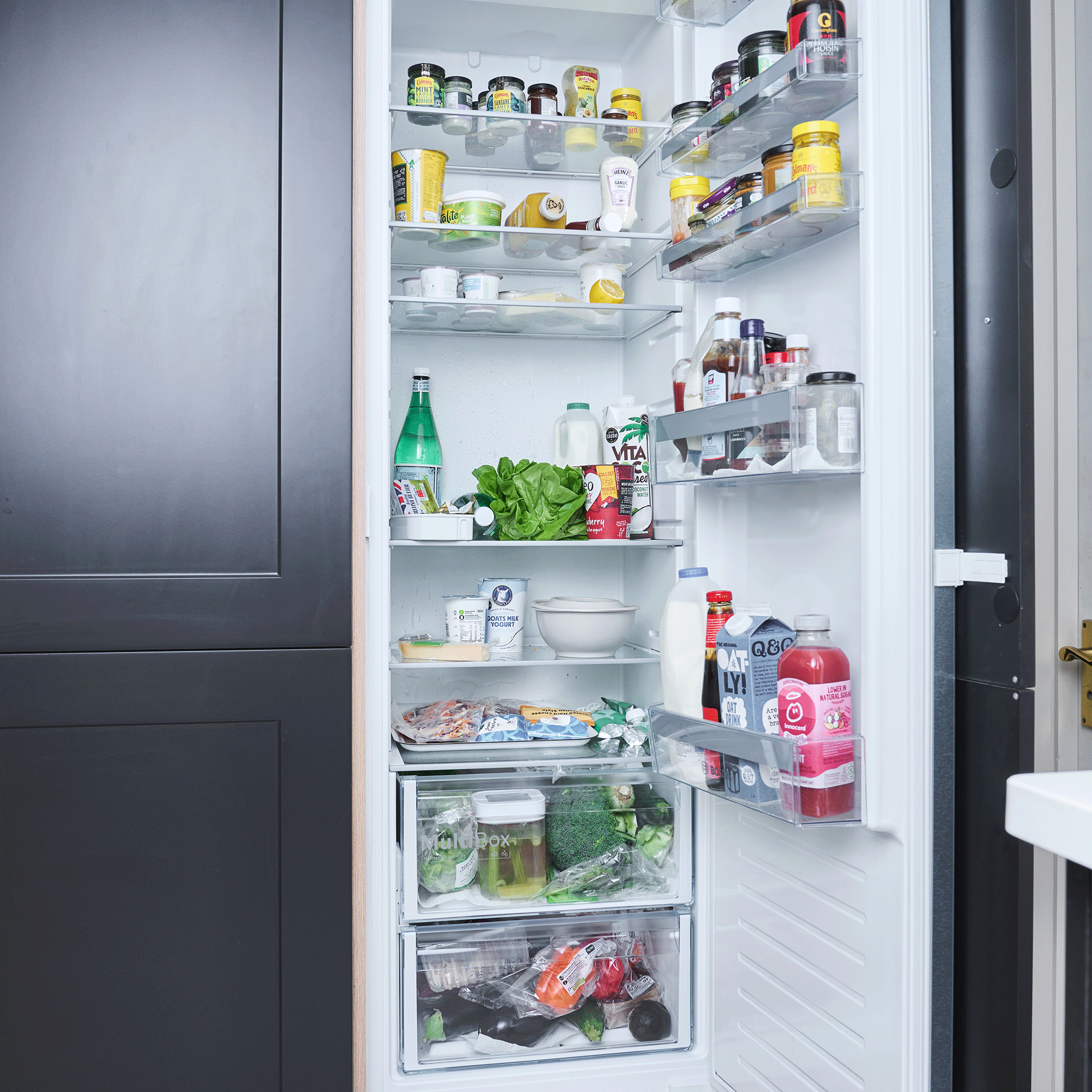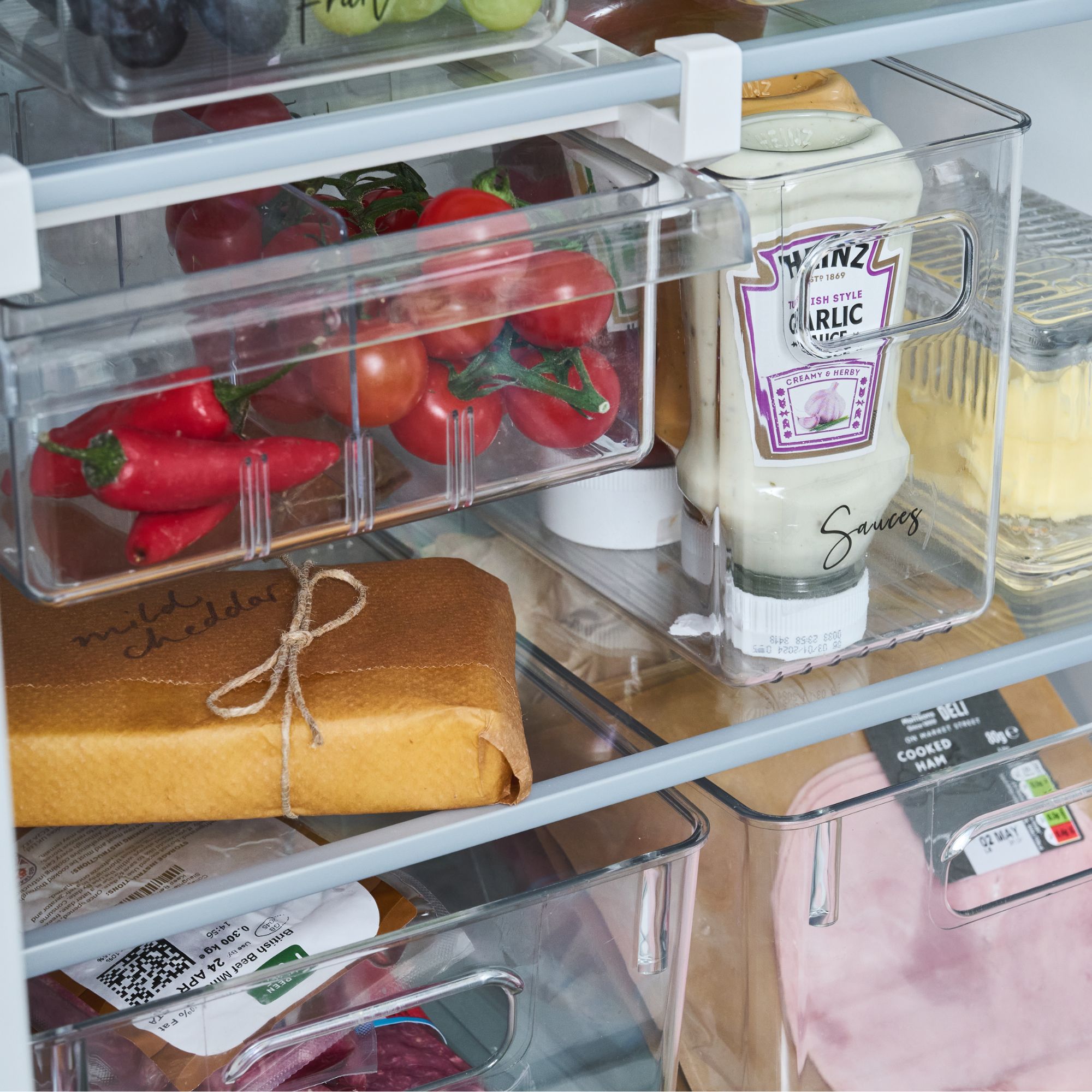
Organising the fridge is one of the most important parts of Christmas prep. After all, the festive food shop is the biggest of the year, and we can't expect our fridge to house everything unless we take the time to arrange it first. Fortunately, you can learn how to organise your fridge quickly (and effectively).
Being greeted by an organised fridge when you come to cook dinner makes everything run far more smoothly. And aside from knowing how to clean your fridge, getting it organised is the next best thing you can do to make festive cooking easier.
We've spoken to experts and asked them how to organise your fridge quickly, so you can get everything in check before the big day. As you'll be starting with pulling everything out of the fridge, it's best to do this on a day where it's fairly empty (so, definitely not straight after you've done the food shop).
1. Declutter (and clean)
The first step to organise your fridge quickly is to pull everything out and get rid of anything that's expired. This will make the organising process much easier, as you'll be able to see everything that needs to go back in the fridge out in front of you.
'First, take everything out of your fridge, and look at the use-by and best-before dates on jars and cartons,' advises Ingrid Jansen and Lesley Spellman from The Declutter Hub. 'The mayonnaises and chutneys are often the ones that go out of date due to us forgetting we’ve opened them in the first place - and then not realising you can only keep these items opened for a few weeks. Throw away anything you can no longer eat.'
Now is also a good time to give all the shelves a wipe down - your fridge won't feel organised if it's grubby inside. Then, try and group all the different food types together (like meat, dairy, condiments, vegetables) before moving on to the next step.

2. Store meat on the bottom shelf
The experts advise working your way up from the bottom as you put the contents back in the fridge. So, start by putting the meat on the bottom shelf.
'To keep your meat fresh for as long as possible and minimise the risk of bacteria growing, store your turkey, fish and other meat at a temperature as close to 0C as possible without going below freezing,' Richard Price, Grocery Expert at Britsuperstore explains. 'This typically means placing it in the coldest section of your fridge.'
After the salad drawers at the bottom, the lowest shelf is the next coldest place in the fridge, which is why it's recommended to store meat there. Meat also tends to take up the most space, so there's usually a bigger gap between the bottom two shelves. You may need to move the middle shelf up even higher to make space for the turkey when the time comes.
3. Put dairy on the top shelf
'The upper shelf and top door rack are the warmest areas in your fridge, so it’s best to store items that can withstand slightly higher temperatures,' Richard explains. 'Dairy products like cheese and butter are less likely to spoil on the top shelf compared to meat or fish.'
Put any dairy products, including yoghurt, cream, and cheese on the top shelf. It's also good to keep butter up here because it will stay slightly softer, and so be easier to spread. You can also put any desserts up here too (though some of our favourite festive desserts, like Christmas pudding and mince pies, can be left out of the fridge altogether.

4. Store remaining meat and gravy on the middle shelf
Given that the middle shelf is in between the temperatures of the bottom and top shelves, the experts advise that you store any meat that couldn't fit on the bottom shelf here. Cooked meats and gravy should ideally be placed in the middle as well.
'This is an ideal spot for items like pigs in blankets and pork stuffing,' Richard says. 'Make sure all meat and fish are securely packaged to prevent cross-contamination. Middle shelves are also good for storing your sauces and pre-cooked dishes, including gravy.'
By storing similar foods together, your fridge will feel nice and orderly - just like when organising kitchen cabinets.
5. Place fruit and veg in the drawers

Most fridges come with salad drawers under the bottom shelf, which are ideal for storing fruit and vegetables. The drawers help veggies stay fresh for longer, as Richard explains.
'These drawers are designed with different humidity and temperature levels, and are often the coldest part of the fridge, making them perfect for common Christmas veggies like sprouts.'
When restocking the fridge, always put newer veggies at the back, and bring older ones to the front, so you remember to use them. Getting through what's already in there is also important for keeping your fridge working optimally (overloading is a common cause of a fridge going wet inside).
6. Stock the door with condiments

The fridge door is the area that gets the most exposure to room temperature, which is why longer lasting items should be stored here. This is the best place for jars of condiments and sauces, as well as eggs (if you prefer to keep yours refrigerated). And while milk is typically stored in the door as well, the experts warn against this.
'Often people store milk in the fridge door for easy access, but this can actually make it expire faster due to the regular exposure to room temperature,' says Nevin Malcok, Refrigeration Category Lead, Hotpoint. 'Instead, save this space for long-lasting items like condiments and sauces.'
7. Use fridge storage solutions
While knowing how to organise your fridge quickly mostly comes down to knowing what should go where, storage solutions can really elevate the system. Clear trays and boxes will keep certain foods together, while still allowing you to see what's inside.
'You can divide foodstuffs into one box for ‘meat’ another for ‘vegetarian’ and so on,' Simon Glanville, Managing Director at A Place for Everything suggests. 'Or with it being Christmas time you could use the boxes to indicate which day or meal the ingredients are for – Christmas Eve supper, Boxing Day etc.'
Food storage solutions are also ideal for meal prepping, which is ideal during the festive period when we want to make things easier on the big day. Some of our favourites include the IKEA KLIPPKAKTUS storage box, and the OXO Reusable Silicone Bags (which are also freezer and dishwasher friendly).
If you're lacking storage space on the fridge door, this is a great alternative for storing condiments. It rotates, which makes for easy grabbing, and keeps jars and bottles conveniently stored together.
Tried and tested by the Ideal Home team, the reusable silicone bags from OXO have definitely got our seal of approval. They're the perfect alternative to tupperware, and are completely leak-proof.
This storage box can really elevate your fridge organisation game. This clips underneath the shelf, giving you extra storage space - perfect for the festive season.
FAQs
In what order should things go in the fridge?
As the bottom half of the fridge is the coldest, it's important to store meat lower down - ideally on the bottom shelf. Dairy products are better able to handle warmer temperatures, so these should go on the top shelf.
'Unless you have a chiller drawer in the fridge, the coldest spot is usually the bottom shelf just above the fruit and vegetable drawers,' Grocery Expert Richard explains. 'So, consider reorganising your bottom shelf so you can store as much unopened meat and fish as possible.'
The middle shelf should be used for meat that won't fit on the bottom shelf, and things like condiments, sauces and eggs should be stored in the fridge door. Put your milk on the top shelf if possible (though you may find it leaks when lying down, in which case, the door is the next best place).
Is the salad drawer the coldest part of the fridge?
Usually, the salad drawer is the coldest part of the fridge. This is because the fridge is coldest at the bottom, and gets (slightly) warmer nearer to the top.
It's recommended to keep fruit and vegetables in the bottom drawers, which will help keep them fresher for longer.
'Leafy greens, berries and other vegetables that are prone to wilting should be kept in a drawer which are designed to keep moisture in,' says Hotpoint's Refrigeration Lead, Nevin Malcock. 'But certain foods that rot and produce ethylene gas – such as apples, pears, and avocados – should be kept separate from the drawer so that the gases don’t speed up the deterioration of other produce.'







